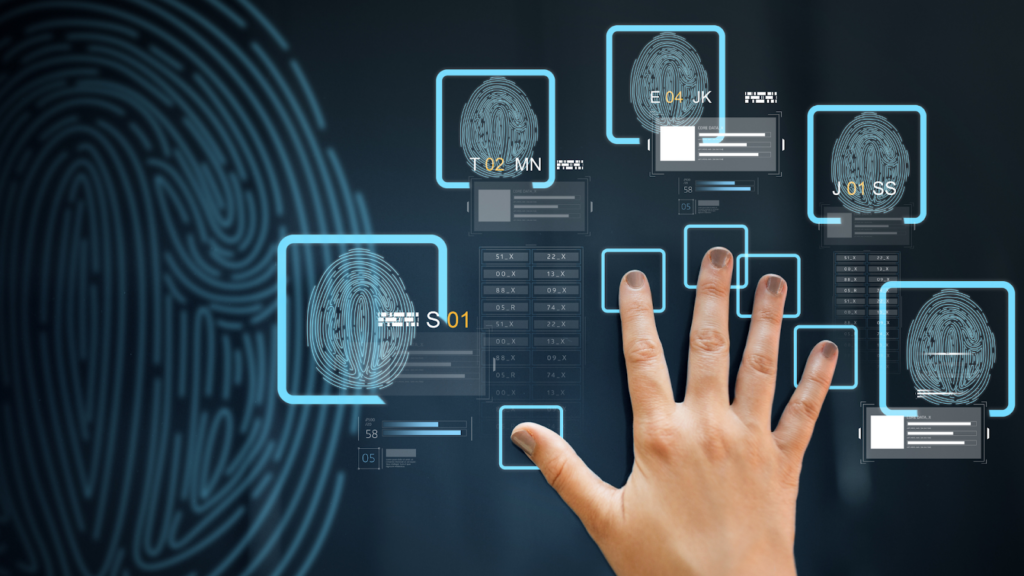Living in the digital era, the concept of identity extends far beyond our physical self. Our online presence, signified through our unique digital fingerprint, plays a vital role in this extension. This complex web of data points tells a story of who we are, what we do, and how we interact online. Digital fingerprinting, coupled with Artificial Intelligence (AI), helps to unravel this story, flagging changes and potential threats.
In this article, we delve into the intricate world of digital fingerprinting, exploring its workings, applications, and the role of AI in enhancing its detection capabilities.
Finding your digital fingerprint is vital, but what’s next? WireX helps you take the next steps in protecting your digital identity. Schedule a demo today to explore advanced cybersecurity tools and start your journey to a safer digital environment.

How Does It Work?
The digital fingerprinting process begins by collecting data from the device or user. This data may include device type, operating system, browser type, IP address, and other digital characteristics.
Once the digital fingerprint has been created, it can be used to identify the device or user and track their activities across the internet. This data can be used for a variety of purposes, such as targeted advertising, anti-fraud and security purposes, and cross-device tracking. This data can also be used to better understand user behavior and preferences.
Understanding how digital fingerprinting works is the first step to securing your online presence. With WireX, you can go beyond understanding and take action to protect your digital assets. Check out WireX Systems’ solutions and start securing your digital identity today.
How Are Digital Fingerprints Created?
Digital fingerprints are created by collecting various data points from a device or user, such as IP address, operating system, browser type, screen resolution, language settings, and more. The data points can also be collected from other sources, such as social media accounts, email addresses, and location data.
- Digital fingerprints can be used to track users over time, such as if a user visits a website from the same device or IP address multiple times.
- AI can be used to analyze the data points and detect changes in user behavior.
Advantages Of Using Digital Fingerprinting
Digital fingerprinting has emerged as a vital tool for tracking online user behavior and device use. This cutting-edge technology has a host of advantages, such as enabling targeted advertising without the use of cookies, providing consistent cross-device tracking, evading standard security tools like ad-blockers, and playing a crucial role in fraud prevention and security.
Enables Targeted Ads And Services Without Cookies
Digital fingerprinting paves the way for advertisers to roll out tailored ads and services without relying on cookies. By amassing and interpreting distinct digital traits – such as device type, operating system, and browser settings – it’s possible to construct a unique digital profile for each user. This profile is resistant to spoofing or falsification, thus making it more secure than cookie-based tracking. This precision targeting based on users’ interests and preferences facilitates improved engagement and conversion rates.
Provides Reliable Cross-Device Tracking
Digital fingerprinting offers consistent tracking across different devices. By collecting device-specific data like operating system type, browser, and hardware specifications, it creates a distinctive digital “fingerprint” for each device. This tracking system can identify changes in a user’s behavior or detect any fraudulent activity, significantly enhancing user security online.
Evades Traditional Security Tools Like Adblockers
Digital fingerprinting can outwit standard security tools, including ad-blockers. It achieves this by building a unique fingerprint based on the user’s device and activity data. This personalized fingerprint is then used for user identification and activity tracking.
Useful For Anti-Fraud And Security Purposes
Digital fingerprinting is instrumental in identifying and mitigating suspicious activities like identity theft, financial fraud, and data breaches. It can spot irregular transactions and track cybercriminal activity, aiding in the prevention of data breaches. Furthermore, it is highly effective in detecting phishing attacks and preventing malware infections.
Types Of Digital Fingerprinting
Digital fingerprinting technology is primarily divided into two categories: browser fingerprinting and device fingerprinting. Both aim to generate a unique user identifier, ensuring reliable and secure data collection.
Browser Fingerprinting
Browser fingerprinting leverages a user’s web browser configuration to generate a unique identifier. Data such as the browser type, operating system, plugins, and settings are collected and synthesized to create a unique “fingerprint” specific to a user’s device. This method is increasingly popular for identifying and tracking users without cookies while flagging suspicious activities. Users should, however, be aware of potential privacy implications.
Device Fingerprinting
Device fingerprinting creates a distinctive identifier for each device, making it an indispensable tool for various sectors, including banks, governments, and advertisers. Users can protect against device fingerprinting by ensuring their devices are secure, using VPNs, and disabling cookies and other tracking technologies.
Who Uses Digital Fingerprinting?
Various organizations use digital fingerprinting technology for different purposes.
Banks And Governments
Banks and governments utilize digital fingerprinting as a security layer, using it to identify suspicious activities, prevent fraud, and safeguard against financial losses. Governments also use digital fingerprints to monitor online activities and identify potential threats. This technology also aids in improving customer experience through tailored offers.
Advertisers
Advertisers exploit digital fingerprinting to deliver personalized ads to specific audiences. By identifying users across various devices, they can tailor ads to suit the user’s interests, optimizing their marketing campaigns.
Hackers
Unfortunately, digital fingerprinting is also used by hackers to access sensitive information. It allows them to mimic a user or device, granting them unauthorized access to confidential data.
Data Brokers
Data brokers are companies that collect and sell personal data from consumers, such as names, addresses, phone numbers, email addresses, and other identifying information. They use this data to create detailed consumer profiles that are used for marketing, advertising, and other purposes.
Digital fingerprinting can be used by data brokers to track consumer behavior across multiple devices, identify users across multiple devices, detect fraud and other security threats, and create detailed consumer profiles.
Political Campaigners
Political campaigners use digital fingerprinting to target specific audiences with customized messages. Digital fingerprinting can help them:
- Identify potential voters and tailor their messaging to those individuals to maximize the impact of their campaigns and reach the right people with the right message.
- Track the effectiveness of their campaigns by analyzing how many people are responding to their messages and which messages are resonating the most.
Fingerprint-Based vs. Non-Fingerprint Background Check
Two primary methods exist to verify an individual’s identity – fingerprint-based and non-fingerprint background checks. Fingerprint-based background checks require individuals to provide a physical sample of their fingerprints for comparison with an established database. These checks stand as a highly reliable and efficient method of identity verification due to the unique nature of fingerprints.
Incorporating AI-based digital fingerprinting with traditional fingerprint-based checks can enhance their effectiveness. This approach enables organizations to promptly identify and scrutinize potential security risks or fraudulent activities.
Contrastingly, non-fingerprint background checks utilize different identification forms like a driver’s license or passport for verification. However, these checks may not offer the same level of reliability and security as their fingerprint-based counterparts.
How Does AI Flag Shifting Patterns With Digital Fingerprinting?
AI can be used to flag shifting patterns with digital fingerprinting by analyzing data from multiple sources. This data can include user behavior, device information, and other factors that can be used to identify a particular user or device. AI can help to detect patterns that may indicate suspicious activity or fraud.
For example, if a particular user or device suddenly begins to access different websites or services than they normally do, this could be an indication of malicious activity. AI can also detect changes in the way a user interacts with a website or application, such as if they suddenly start using a different browser or operating system.
How to Find Your Digital Fingerprint
To find out what your digital fingerprint looks like, you can use an online tool, examine the data sent to websites when you visit them or use a data broker.
Once you have your digital fingerprint, you can use it to understand more about your online activities and how they are being tracked. It can also be used to protect your privacy and security online by allowing you to limit the amount of data that is collected about you.
Additionally, it can be used to find out if you are the target of malicious activities such as identity theft and fraud.

Defend Against Digital Fingerprinting
Defending against digital fingerprinting can be tricky, but a few steps can be taken to help reduce the risk of being identified and tracked online.
- The first step is using a secure browser, such as Chrome and Firefox, and a Virtual Private Network (VPN).
- The second step is to use a privacy-focused web browser, such as Brave and DuckDuckGo, and to be aware of the websites that you visit.
- Finally, it is important to read the privacy policies of the websites you visit and be cautious when providing any personal information online.
Discover The Power Of Digital Fingerprinting With WireX!
Digital fingerprinting stands as a transformative technology, playing a pivotal role in data identification and tracking in the digital realm. Leveraging its power, industries worldwide ensure robust cross-device tracking, deliver targeted advertisements and services, and reinforce anti-fraud and security measures.
At the forefront of this technological revolution is WireX Systems, offering an unparalleled suite of digital solutions. Our capabilities extend beyond the ordinary, empowering organizations to safeguard their invaluable data and protect their clientele. Experience the future of digital security with WireX Systems, where innovation meets integrity.
Final Thoughts
The traces we leave behind – our digital fingerprints – have far-reaching implications. As we continue to integrate our lives with the digital world, staying informed and taking proactive steps towards securing our online presence is no longer an option, but a necessity.
With WireX, you can go beyond understanding and take action to protect your digital assets. Connect with the WireX Systems team and start securing your digital identity today.
Also Check Out:
- What Is Threat Detection And Response (TDR)?
- 5 Steps To Successfully Develop An Incident Response Plan
- 9 Vulnerable Areas In Cyber Security You Can’t Afford To Ignore
FAQs
How is fingerprint data stored digitally?
Fingerprint data is stored digitally by capturing an image of the fingerprint and then converting it into digital data. This data is typically stored in a secure database and can be used for identification purposes.
What is digital fingerprint technology used for?
Digital fingerprint technology is used for a variety of purposes, including authentication, identification, and tracking. It is commonly used by banks and other financial institutions to verify a user’s identity and by law enforcement to identify criminals. It is also used in digital marketing to track user behavior and target ads.
How secure is fingerprint recognition?
Fingerprint recognition is considered to be one of the most secure forms of biometric authentication. It is difficult to spoof or replicate a fingerprint, making it an effective way to verify a user’s identity.
What are the challenges of fingerprinting?
One of the biggest challenges of fingerprinting is that the technology is not 100% accurate. False positives and false negatives can occur, resulting in the wrong person being identified or a person’s identity being wrongly denied.
What types of information can be part of a digital fingerprint?
A digital fingerprint can include a variety of information, including device type, operating system, browser type, IP address, and more. It can also include information about a user’s online behavior, such as the websites they visit and the ads they click.






